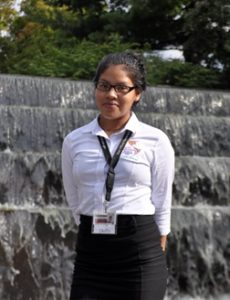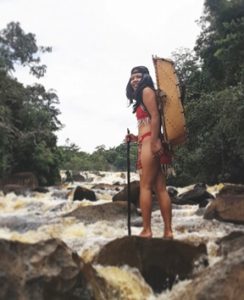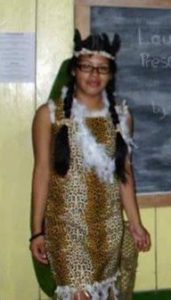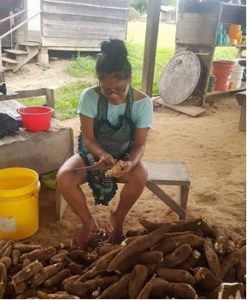Dolly Chambers belongs to one of the four founding families of her village, Paruima, who are said to be the only remaining families of the Arecuna nation.
The 18-year-old was born in Kamarang village, Region Seven. She attended Paruima Primary School, and then went on to Graham’s Hall Primary and St. Stanislaus College in Georgetown. She is of the Arecuna nation.

Brief history of Paruima
The tallest of our indigenous peoples, the Arecunas, who refer to themselves as “pemon” meaning “the people”, occupy upper and central Kamarang river since 1839. They are presently concentrated at Paruima, which is located on the Kamarang river in the Upper Mazaruni District.
Paruima was founded by four friends who settled in the area: Percy, Henrito, McNaughton and Chambers. Paruima got its name from the large plantains called ‘paruru’ that are grown in the village.
Today, there are approximately 715 persons living in Paruima, a Seventh-day Adventist community. It is surrounded by forested mountain slopes. The village’s main economic activity is subsistence farming. Interestingly, it is the only Arecuna village in Guyana.
Cultural Preservation Project
In an interview with Sunday Times Magazine, Dolly said she was inspired to start her cultural preservation project after visiting the US in 2015, where she represented Guyana at the Youth Ambassadors’ Program along with four other [Guyanese] students, one mentor and 30 students from across the Caribbean. Dolly noted that the programme impacted her life significantly.

“After experiencing the cultural riches of Rapid City, South Dakota, US, via museums and galleries that both preserved heritage and move artistic expressions forward, I was motivated to establish an indigenous museum in Guyana. Attending a traditional ‘Powwow’ was one which I certainly enjoyed. I danced and interacted with the Lakota tribe. I was able to see the similarities and differences between the Arecunas and the Lakotas. I was very much impressed of the way indigenous culture is preserved in Rapid City. I realised that there is so much that we can do to preserve our culture,” she expressed.
Dolly added due to there being only one village in Guyana that is home to the Arecunas, she believes her project can help in the preservation of the Arecuna culture for future generations, “who may not practice the cultural heritage in the future due to the introduction of technology”.
“I am aware a museum cannot start in one day, so I decided to implement a cultural preservation project in my village, Paruima, as a start. I also plan on compiling a book of Arecuna recipes and a story book. I visited homes to gather information and made appointments with the elders so that I can record their stories. Many persons prepare their meals differently, so I had to collect several recipes used to prepare one meal and just record the most popular method. Currently, I am editing my recipe book so that the final draft can be submitted by September 15. I need help with transportation to go back home to take photographs of the prepared traditional foods, since it is heritage month, and professional photographers to help me execute that,” she pointed out.

Dolly’s objectives are to increase awareness and appreciation of the culture and traditions of the Arecuna people, highlight aspects of the culture or traditions of the Arecuna nation that are threatened, and identify and recommend areas of preservation.
“By early next year, I want to publish a story book and a recipe book. For my next project, I would like to compile a book on Arecuna medicines. However, I cannot do it alone. I’ve struggled through the past year alone. Also, I would like to record and learn the steps for the four main dances. I would like to establish an indigenous museum in Guyana as my long term goal. Times are changing and our children need to know about themselves and their ancestors. One year ago, I didn’t know a lot, but today I can say differently. I’ve learned a lot during the past month about my cultural heritage,” Dolly declared.

The aspiring architect is currently a contestant in the Miss Indigenous Heritage Month Pageant 2017, which is scheduled for September 30 at the National Cultural Centre. She stated that winning the pageant will give her the “boost to continue initiating and executing cultural projects, because there is a budget allocated for that via the pageant”.



